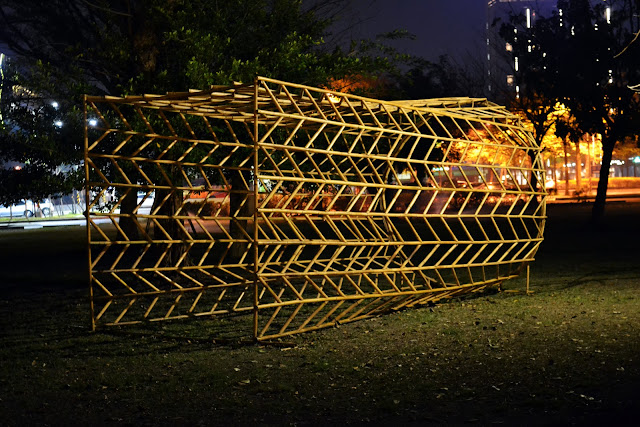PORT OF IDENTITY— 認同口 (2019)
public sculpture | mosso bamboo | 2.5x2.5x5 m
Pier-2 Art Center, 駁二藝術特區 大義公園 Dayi Park, Kaohsiung, TAIWAN
The public sculpture ‘Port of Identity’ focuses on Taiwanese identity in an abstract way. Geometric patterns are used in Taiwan contain the whole course of history. Tattoos of Indigenous People, symbols of religions, different patterns brought by migration and occupations and many ancient knowledge are coded in the lines of architecture, graphic decorations and clothes. Can Taiwanese identity be captured in these patterns? By visualising their special way of thinking, these symbols represent the people of Formosa and their unique nation.
public sculpture | mosso bamboo | 2.5x2.5x5 m
Pier-2 Art Center, 駁二藝術特區 大義公園 Dayi Park, Kaohsiung, TAIWAN
The public sculpture ‘Port of Identity’ focuses on Taiwanese identity in an abstract way. Geometric patterns are used in Taiwan contain the whole course of history. Tattoos of Indigenous People, symbols of religions, different patterns brought by migration and occupations and many ancient knowledge are coded in the lines of architecture, graphic decorations and clothes. Can Taiwanese identity be captured in these patterns? By visualising their special way of thinking, these symbols represent the people of Formosa and their unique nation.
The sculpture is also inspired by gates offering good luck after
crossing them, such as the Dragon Tiger Pavilion in Lotus Lake, Kaohsiung
City. The gate-like sculpture has two different doors: a square and a
circle one. This shape – known as the lucky coins –
is a symbol
of wealth and prosperity. These forms carry the idea
of self-development: changing from square into a circle. They represent earth (square) and heaven or sky (circle)
and symbolise a person and the community.
The geometric shapes are also strongly connected
to nature, elements and the search of balance. The work evokes the wave
patterns used by Paiwan Indigenous
People. With the use of bamboo, the work also refers to
Taiwanese traditional architecture, and by applying only natural materials, it
is dedicated to the protection of the environment.
The sculpture stands in
the Dayi Park, Kaohsiung Port, besides the warehouses of the Pier-2 Art
Center. The project was created during the Pier-2 Artist in Residency program
in 2019.
認同口 (2019)
公共雕塑 | 孟宗竹 | 2.5x2.5x5 m
駁二藝術特區 大義公園
公共雕塑 | 孟宗竹 | 2.5x2.5x5 m
駁二藝術特區 大義公園
「認同口」以抽象的方式刻劃台灣認同。 自古至今,幾何花樣被廣為使用:原住民的刺青、宗教象徵、透過殖民與移民帶來的新圖樣…。很多遠古的知識皆藏匿在建築、裝飾、服飾的線條裡。我們是否可以從這些樣式看出台灣的身分認同?透過將獨特的思考視覺化,這些符號代表了福爾摩沙的人民和他們獨特的族群。
藝術家在參訪蓮池潭龍虎塔時受到民間習俗中,「龍頭進,虎口出」消災解厄增吉祥討吉利來獲得好運的啟發,「認同口」有兩個門,一邊是正方形一邊是圓形。這個造型(也代表錢幣)是對於財富強而有力的象徵。這個形體帶有自我發展,從方化為圓。他們代表了地(方)與天(圓)或是人與社會之間的對應。
「認同口」同時也與自然、元素、以及追求平衡互相連結。雕塑裡採用了排灣族特有的波浪紋路。另一方面,竹子是台灣傳統建築中時常使用的材料,希望藉由選用此媒材以示藝術家冀望保護環境的心。
作品為現地裝置,坐落於靠近駁二藝術特區倉庫旁的大義公園,這個裝置完成於2019駁二藝術家駐村計畫期間。
藝術家在參訪蓮池潭龍虎塔時受到民間習俗中,「龍頭進,虎口出」消災解厄增吉祥討吉利來獲得好運的啟發,「認同口」有兩個門,一邊是正方形一邊是圓形。這個造型(也代表錢幣)是對於財富強而有力的象徵。這個形體帶有自我發展,從方化為圓。他們代表了地(方)與天(圓)或是人與社會之間的對應。
「認同口」同時也與自然、元素、以及追求平衡互相連結。雕塑裡採用了排灣族特有的波浪紋路。另一方面,竹子是台灣傳統建築中時常使用的材料,希望藉由選用此媒材以示藝術家冀望保護環境的心。
作品為現地裝置,坐落於靠近駁二藝術特區倉庫旁的大義公園,這個裝置完成於2019駁二藝術家駐村計畫期間。
VIDEO by Pier-2 Art Center駁二藝術特區 AiR program 製作- 看不見電影工作室 Unseen Film Studio. Special thanks to Sun Chieh Heng;
Chia-Chen Chung and to Pier-2 Art Center, Kao Hsiung City, Taiwan




























